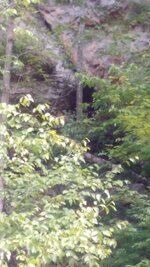John Filson is the first person known to have (referenced the mine) following Swift's death. In 1788, (Filson claimed a tract of land supposed to have included a silver mine) worked by "a certain man named Swift." Filson disappeared, taking with him any knowledge he may have had as to the mine's location. if you think he mapped all of eastern Kentucky by him self, well he more than likely paid or kind of borrowed from other land surveyors. he did get a book on Kentucky published, by the size of this undertaking he must have had help? he had land here because of the war.
he added the swift story, so he could sell land and it helps if the mines are on the land grant. he owed a lot of money and he was getting boxed into a corner. all of sudden he disappears next to the ohio river in ohio how convenient. hmmm? has for a lot of the stories passed down. I have found carvings in Kentucky, Virginia, west Virginia and Tennessee. they all seem to be the same. odd that so many have sharp edges and not worn down by weather. people in the different areas found carvings and claimed they must be clues to the mines and they must be close by. stories were past down from father to son for years. over the years I have been shown carvings and supposed mine openings that were claimed to be swifts. a lot were done by Indians, hunters, Spanish and French and don't forget the civil war. oh and don't forget the books that came out telling about the huge wealth that lies in the hills. yes their is silver and gold out their, but don't go searching for just one set of mines. research vary carefully because it may be indian, French or Spanish and also it could be the civil war or later. remember that research and follow up at the area is the most important part of treasure hunting. I know, I know i'm rambling on.
he added the swift story, so he could sell land and it helps if the mines are on the land grant. he owed a lot of money and he was getting boxed into a corner. all of sudden he disappears next to the ohio river in ohio how convenient. hmmm? has for a lot of the stories passed down. I have found carvings in Kentucky, Virginia, west Virginia and Tennessee. they all seem to be the same. odd that so many have sharp edges and not worn down by weather. people in the different areas found carvings and claimed they must be clues to the mines and they must be close by. stories were past down from father to son for years. over the years I have been shown carvings and supposed mine openings that were claimed to be swifts. a lot were done by Indians, hunters, Spanish and French and don't forget the civil war. oh and don't forget the books that came out telling about the huge wealth that lies in the hills. yes their is silver and gold out their, but don't go searching for just one set of mines. research vary carefully because it may be indian, French or Spanish and also it could be the civil war or later. remember that research and follow up at the area is the most important part of treasure hunting. I know, I know i'm rambling on.






